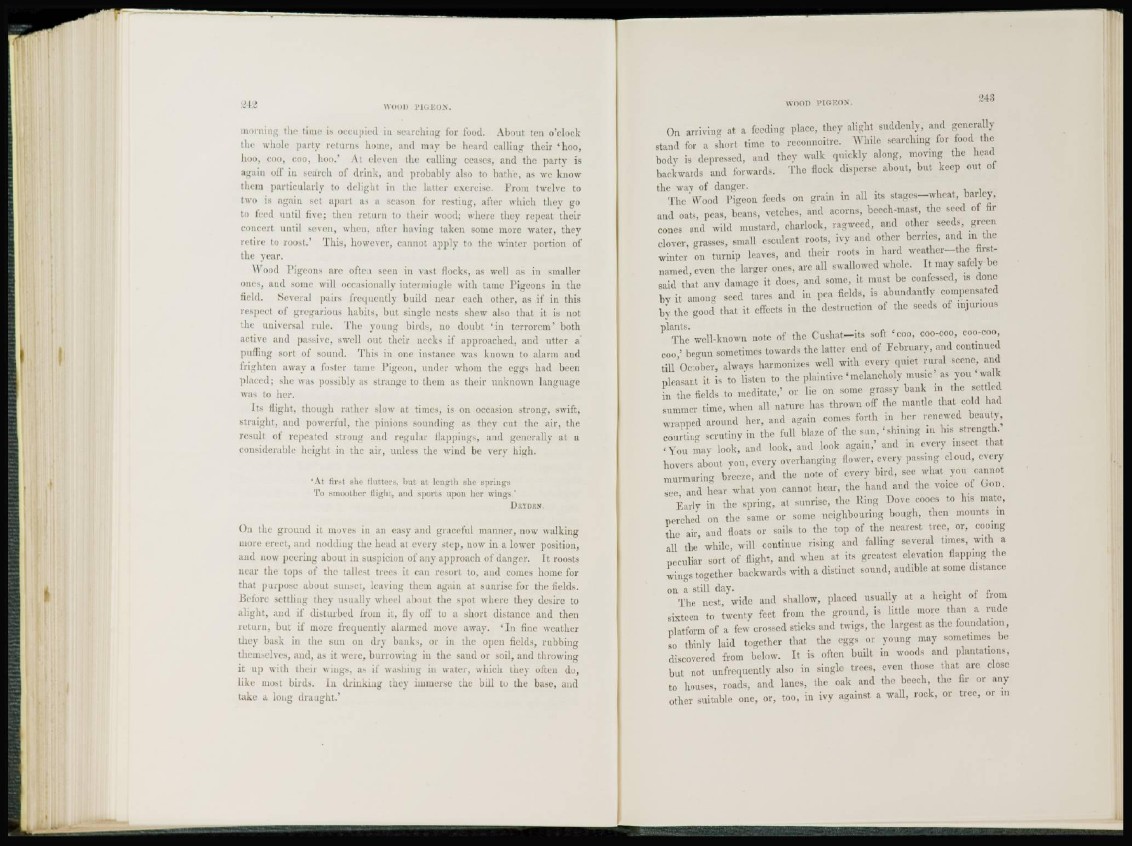
morning the time is occupied in searching for food. About ton o'clock
the whole parly returns home, and may be heard calling their ' b o o .
hoo, coo, coo, hoo.' At eleven the calling ceases, and the party is
again off in search of drink, and probably also to bathe, as we know
them particularly to delight in the latter exercise. From twelve to
two is again set apart as a season for resting, after which they go
to feed until five; then return to their wood; where they repeat their
concert until seven, when, alter having taken some more water, they
retire to roost.* This, however, cannot apply to the winter portion of
the year.
Wood Pigeons are oftea seen in vast flocks, as well as in smaller
ones, and some will occasionally intermingle with tame Pigeons in the
field. Several pairs frequently build near each other, as if in this
respect of gregarious habits, but single nests shew also that it is not
the universal rule. The young birds, no doubt ' in terrorem' both
active and passive, swell out their necks if approached, and utter a
puffing sort of sound. This in one instance was known to alarm and
frighten away a foster tame Pigeon, under whom the eggs had been
placed; she was possibly as strange to them as their unknown language
was to her.
Its flight, though rather slow at times, is on occasion strong, swift,
straight, and powerful, the pinions sounding as they cut the air, the
result of repeated strong and regular flappings, and generally ut a
considerable height in the air, unless the wind be very high.
'At first she (hitters, hut at length slip springs
To smoother Uiglit, utul sports upon her wiugs '
Drydki*.
On the ground it moves in an easy and graceful manner, now walking
more erect, and nodding the head at every s t e p , now in a lower position,
and now peering about in suspicion of any approach of danger. It roosts
near the tops of the tallest trees it can resort to, and comes home for
that purpose about sunset, leaving them again at sunrise for the fields.
Before settling they usually wheel about the spot where they desire to
alight, and if disturbed from it, fly off to a short distance and then
return, but if more frequently alarmed move away. ' I n fine weather
they bask in the sun on dry banks, or in the open fields, rubbing
themselves, and, as it were, burrowing iu the sand or soil, and throwing
it up with their wings, as if washing in water, which they often do,
like most birds. In drinking they immerse the bill to the base, and
take a long draught.'
WOOD PIGEON.
On arriving at a feeding place, they alight suddenly, and generally
stand for a short time to reconnoitre. While searching for food the
body is depressed, and they walk quickly along, moving the head
backwards and forwards. The flock disperse about, but keep out of
the way of danger.
The Wood Pigeon feeds on grain in all its stages—wheat, barley,
and oats, peas, beans, vetches, and acorns, beech-mast, the seed of fir
cones and wild mustard, charlock, ragweed, and other seeds, green
clover, grasses, small esculent roots, ivy and other berries, and in t he
winter on turnip leaves, and their roots in hard weather—the firstnamed,
even the larger ones, arc all swallowed whole. It may safely be
said that anv damage it does, and some, it must be confessed, is done
bv it among seed tares and in pea fields, is abundantly compensated
bv the good that it effects in the destruction of the seeds of injurious
plants.
The well-known note of the Cushat—its soft ccoo, coo-coo, coo-coo,
coo,' begun sometimes towards the latter end of February, and continued
till October, always harmonizes well with every quiet rural scene, and
pleasant it is to listen to the plaintive 'melancholy music' as you ' w a lk
in the fields to meditate,* or lie on some grassy bank in the settled
summer time, when all nature has thrown off the mantle that cold had
wrapped around her, and again comes forth in her renewed beauty,
courting scrutiny in the full blaze of the sun, ' s h i n i n g in his strength.'
' Y o u may look, and look, and look again,' and in every insect that
hovers about you, every overhanging flower, every passing cloud, every
murmuring breeze, and the note of every bird, see what vou cannot
see, and hear what vou cannot hear, the hand and the voice of G O D ,
Early in the spring, at sunrise, the King Dove cooes to his mate,
perched on the same or some neighbouring bough, then mounts in
the air, and floats or sails to the top of the nearest tree, or, cooing
all the while, will continue rising and falling several times, with a
peculiar sort of flight, and when at its greatest elevation flapping the
wings together backwards with a distinct sound, audible at some distance
on a still day.
The nest, wide and shallow, placed usually at a height of from
sixteen to twenty feet from the ground, is little more than a rude
platform of a few crossed sticks and twigs, the largest as the foundation,
so thinly laid together that the eggs or young may sometimes be
discovered from below. It is often built in woods and plantations,
but not uufrequently also in single trees, even those that are close
to houses, roads, and lanes, the oak and the beech, the fir or any
other suitable one, or, too, in ivy against a wall, rock, or tree, or in